Effect of Temperature on Morphologies and Microstructures of Soot Particles in the Diesel Exhaust Pipe
Abstract
:1. Introduction
2. Experimental Description
2.1. Engine and Sampling Devices
2.2. Experimental Scheme and Method
3. Morphologies of Soot Particles
4. Microstructures of Soot Particles
5. Conclusions
- (1)
- Under all load conditions, dp, Rg, and Np of soot particles at sampling point 2a were greater than those at sampling point 1. At BMEP = 1.13 MPa, the increases in dp, Rg, and Np were the least, as they only increased by 6.64%, 6.27%, and 6.44%, respectively. This meant that when soot particles in the exhaust pipe moved with the exhaust gas to the atmosphere, soot particles still grew through surface chemical reactions and physical processes, such as collision, coagulation, and breakage.
- (2)
- As the loads increased, Df increased from 1.59 to 1.91, and simple chain-like and branched soot particles developed into complex cluster-like and mesh-like soot particles. When the load was the same, the fractal dimension of soot particles at sampling point 2a was larger than that at the sampling point 1, and soot particles agglomerated more and more as the exhaust gas moved through the exhaust pipe.
- (3)
- The increase in the airflow temperature in the exhaust pipe promoted the surface growth of primary soot particles and enhanced the turbulence, which made the chain-like soot particles more likely to exhibit tortuosity under the action of turbulent eddies, that is, Rg decreased and Df increased. Compared to Df at sampling point 2a, Df at sampling point 2b increased by 1.16%, 0.47%, 1.44%, and 2.21%, respectively, as a function of BMEPs.
- (4)
- The average Ds and Tf of primary soot particles at sampling point 2b deceased, especially under BMEP = 1.13 MPa as Ds and Tf decreased by 4.46% and 6.0%, respectively. This showed that the increase in the temperature of the exhaust pipe was conducive to the graphitization of primary soot particles.
Author Contributions
Funding
Data Availability Statement
Conflicts of Interest
References
- Robert, H.H.; Gregory, P.C.; Hong-shig, S. Equilibrium nanostructure of primary soot particles. Proc. Combust. Inst. 2000, 28, 2539–2546. [Google Scholar]
- Robert, A.K. Recent changes in winter PM2.5 contributions from wood smoke, motor vehicles, and other sources in the Northwest U.S. Atmos. Environ. 2020, 237, 117724. [Google Scholar]
- Feiyang, Z.; Wenming, Y.; Wenbin, Y.; Han, L.; Yu, Y.S.; Teng, L.; Kun, L.T. Numerical study of soot particles from low temperature combustion of engine fueled with diesel fuel and unsaturation biodiesel fuels. Appl. Energy 2018, 211, 187–193. [Google Scholar]
- Pavan, P.D.; Sujith, S.; Rajesh, K.S.; Sheshadri, S. Modeling soot particle size distribution in diesel engines. Fuel 2019, 243, 70–78. [Google Scholar]
- Suhonen, H.; Laitinen, A.; Kortelainen, M.; Koponen, H.; Kinnunen, N.; Suvanto, M. Novel fine particle reduction method for wood stoves based on high-temperature electric collection of naturally charged soot particles. J. Clean. Prod. 2021, 312, 127831. [Google Scholar] [CrossRef]
- Xiao, Z.; Tang, Y.; Zhou, J.; Yao, Q. Effect of the interaction between sodium and soot on fine particle formation in the early stage of coal combustion. Fuel 2017, 206, 546–554. [Google Scholar] [CrossRef]
- Chowdhury, S.; Boyette, W.; Roberts, W.L. Time-averaged probability density functions of soot nanoparticles along the centerline of a piloted turbulent diffusion flame using a scanning mobility particle sizer. J. Aerosol Sci. 2017, 106, 56–67. [Google Scholar] [CrossRef]
- De Falco, G.; El Helou, I.; de Oliveira, P.M.; Sirignano, M.; Yuan, R.; D’Anna, A.; Mastorakos, E. Soot particle size distribution measurements in a turbulent ethylene swirl flame. Proc. Combust. Inst. 2021, 38, 2691–2699. [Google Scholar] [CrossRef]
- Xiao, H.; Xiaolong, Y.; Beibei, H.; Wang, R.; Xue, Q.; Ju, H. Combustion performance and pollutant emissions analysis of a diesel engine fueled with biodiesel and its blend with 2-methylfuran. Fuel 2019, 237, 1050–1056. [Google Scholar] [CrossRef]
- Lee, Y.; Lee, Y.; Moon, S.; Lee, S.; Roh, Y.; Min, K. Development of semi-empirical soot emission model for a CI engine. Sci. Total Environ. 2022, 820, 153327. [Google Scholar] [CrossRef]
- Michelsen, H.A. Probing soot formation, chemical and physical evolution, and oxidation: A review of in situ diagnostic techniques and needs. Proc. Combust. Inst. 2017, 36, 717–735. [Google Scholar] [CrossRef]
- Tian, R.; Zhang, Y.; Kook, S.; Kim, K.S.; Kweon, C. Effect of jet fuel aromatics on in-flame soot distribution and particle morphology in a small-bore compression ignition engine. Fuel 2021, 305, 121582. [Google Scholar] [CrossRef]
- Wei, J.; Zeng, Y.; Pan, M.; Zhuang, Y.; Qiu, L.; Zhou, T. Morphology analysis of soot particles from a modern diesel engine fueled with different types of oxygenated fuels. Fuel 2020, 267, 117248. [Google Scholar] [CrossRef]
- Kiminori, O.; Miki, Y.; Sho, T.; Yasuhiro, S.; Hideyuki, A.; Okiteru, F.; Takayuki, A.; Togo, Y. Influence of furnace temperature and residence time on configurations of carbon black. Chem. Eng. J. 2012, 200–202, 541–548. [Google Scholar]
- Wang, X.; Wang, Y.; Bai, Y.; Wang, P.; Wang, D.; Guo, F. Effects of 2, 5-dimethylfuran addition on morphology, nanostructure and oxidation reactivity of diesel exhaust particles. Fuel 2019, 253, 731–740. [Google Scholar] [CrossRef]
- Liu, Y.; Xu, Y.; Zhang, K.; Zhang, P.; Cheng, X. Effects of ammonia addition on soot formation in ethylene laminar diffusion flames. Part 3. The morphology and nanostructure of soot particles. Fuel 2023, 332, 126082. [Google Scholar] [CrossRef]
- Amin, H.M.F.; Bennett, A.; Roberts, W.L. Morphology of soot sampled from N2-diluted methane/air counterflow flames at elevated pressures via TEM imaging. Combust. Flame 2020, 216, 92–99. [Google Scholar] [CrossRef] [Green Version]
- Sipkens, T.A.; Frei, M.; Baldelli, A.; Kirchen, P.; Kruis, F.E.; Rogak, S.N. Characterizing soot in TEM images using a convolutional neural network. Powder Technol. 2021, 387, 313–324. [Google Scholar] [CrossRef]
- Schulz, F.; Commodo, M.; Kaiser, K.; Falco, G.D.; Minutolo, P.; Meyer, G.; D’Anna, A.; Gross, L. Insights into incipient soot formation by atomic force microscopy. Proc. Combust. Inst. 2019, 37, 885–892. [Google Scholar] [CrossRef]
- Commodo, M.; Kaiser, K.; De Falco, G.D.; Minutolo, P.; Schulz, F.; D’Anna, A.; Gross, L. On the early stages of soot formation: Molecular structure elucidation by high-resolution atomic force microscopy. Combust. Flame 2019, 205, 154–164. [Google Scholar] [CrossRef]
- Schenk, M.; Lieb, S.; Vieker, H.; Beyer, A.; Gölzhäuser, A.; Wang, H.; Kohse-Höinghaus, K. Morphology of nascent soot in ethylene flames. Proc. Combust. Inst. 2015, 35, 1879–1886. [Google Scholar] [CrossRef]
- Veronesi, S.; Commodo, M.; Basta, L.; Falco, G.D.; Minutolo, P.; Kateris, N.; Wang, H.; D’Anna, A.; Heun, S. Morphology and electronic properties of incipient soot by scanning tunneling microscopy and spectroscopy. Combust. Flame 2022, 243, 111980. [Google Scholar] [CrossRef]
- Yu, W.; Suk, H.C. Soot formation in laminar counterflow flames. Prog. Energy Combust. Sci. 2019, 74, 152–238. [Google Scholar]
- Michelsen, H.A.; Colket, M.B.; Bengtsson, P.; D’Anna, A.; Desgroux, P.; Haynes, B.S.; Miller, J.H.; Nathan, G.J.; Pitsch, H.; Wang, H. A Review of Terminology Used to Describe Soot Formation and Evolution under Combustion and Pyrolytic Conditions. ACS Nano 2020, 14, 12470–12490. [Google Scholar] [CrossRef]
- Martin, J.W.; Pascazio, L.; Menon, A.; Akroyd, J.; Kaiser, K.; Schulz, F.; Commodo, A.; D’Anna, A.; Gross, L.; Kraft, M. π-Diradical Aromatic Soot Precursors in Flames. J. Am. Chem. Soc. 2021, 143, 12212–12219. [Google Scholar] [CrossRef]
- Wei, M.; Wu, S.; Mao, Q.; Wang, Y.; Guo, G.; Zhang, D. The oxidation mechanism investigation of benzene catalyzed by palladium nanoparticle: A ReaxFF molecular dynamics. Fuel 2020, 275, 117989. [Google Scholar] [CrossRef]
- De Falco, G.; Commodo, M.; Minutolo, P.D.; Anna, A. Flame-Formed Carbon Nanoparticles: Morphology, Interaction Forces, and Hamaker Constant from AFM. Aerosol Sci. Technol. 2015, 49, 281–289. [Google Scholar] [CrossRef]
- Schaefer, D.W. Fractal Models and the Structure of Materials. MRS Bull. 1988, 13, 22–27. [Google Scholar] [CrossRef]
- Liang, B.; Wang, C.; Zhang, Y.; Liu, B.; Zeng, F.; Shadrack, A.T.; Paitoon, T. Effect of CO2/H2O addition on laminar diffusion flame structure and soot formation of oxygen-enriched ethylene. J. Energy Inst. 2022, 102, 160–175. [Google Scholar]
- Jiang, H.; Li, T.; Wang, Y.; He, P.; Wang, B. The evolution of soot morphology and nanostructure along axial direction in diesel spray jet flames. Combust. Flame 2019, 199, 204–212. [Google Scholar] [CrossRef]
- Felix, S.H.; Joonsik, H.; Choongsik, P.; Tarun, G.; Avinash, K.A. Nanostructure characterization of soot particles from biodiesel and diesel spray flame in a constant volume combustion chamber. Fuel 2019, 235, 130–149. [Google Scholar]
- Liu, X.; Liu, J.; Zhao, L.; Ma, Z.; Li, J.; Wang, X.; Chen, W.; He, C. Effects of operating conditions on the morphology and internal structure of soot particles emitted from an agricultural tractor. Biosyst. Eng. 2020, 198, 280–290. [Google Scholar] [CrossRef]
- Behzad, R.; Choongsik, B. Morphology and nano-structure of soot in diesel spray and in engine exhaust. Fuel 2017, 203, 47–56. [Google Scholar]
- Sanghoon, K.; Zhang, R.; Kevin, S.; Lyle, M.P.; Tetsuya, A. In-Flame Soot Sampling and Particle Analysis in a Diesel Engine. SAE Int. J. Fuels Lubr. 2013, 6, 80–97. [Google Scholar]
- Teruo, Y.; Katsufumi, K.; Hiroki, N.; Satoshi, T.; Tetsuya, A. Direct Sampling, TEM Analysis and Optical Measurement of Soot Particles at Different Axial Locations in a Transient Spray Flame. SAE Int. J. Fuels Lubr. 2012, 5, 316–328. [Google Scholar]
- Chen, H.; Wang, X.; Pan, Z. Effect of operation conditions on the chemical composition, morphology, and nano-structure of particulate emissions in a light hydrocarbon premixed charge compression ignition (PCCI) engine. Sci. Total Environ. 2021, 750, 141716. [Google Scholar] [CrossRef] [PubMed]
- Pfau, S.A.; Rocca, A.L.; Haffner-Staton, E.; Fay, M.W.; Cairns, A. Linking operating conditions of a GDI engine to the nature and nanostructure of ultrafine soot particles. Combust. Flame 2022, 245, 112315. [Google Scholar] [CrossRef]
- Liang, X.; Zhao, B.; Wang, K.; Lv, X.; Wang, Y.; Liu, J.; Wang, Y. Impact of multi-injection strategies on morphology, nanostructure and oxidation reactivity of diesel soot particles. Combust. Flame 2022, 237, 111854. [Google Scholar] [CrossRef]
- Ge, J.C.; Wu, G.; Choi, N.J. Comparative study of pilot-main injection timings and diesel/ethanol binary blends on combustion, emission and microstructure of particles emitted from diesel engines. Fuel 2022, 313, 122658. [Google Scholar] [CrossRef]
- Ge, J.C.; Wu, G.; Yoo, B.; Choi, N.J. Effect of injection timing on combustion, emission and particle morphology of an old diesel engine fueled with ternary blends at low idling operations. Energy 2022, 253, 124150. [Google Scholar] [CrossRef]
- Di, Y.; Zhang, J.; Cheung, C.S.; Miao, X.; Zheng, J.; Peng, H.; Wu, T. Comparative study on combustion and particulate emissions for diesel-biodiesel and diesel –diglyme blends. Fuel 2022, 313, 122710. [Google Scholar]
- Zhou, Q.; Wang, Y.; Wang, X.; Bai, Y. Experimental investigation into the oxidation reactivity, morphology and graphitization of soot particles from diesel/n-octanol mixtures. J. Environ. Sci. 2022, 11, 218–230. [Google Scholar] [CrossRef]
- Verma, P.; Jafari, M.; Zare, A.; Pickering, E.; Guo, Y.; Osuagwu, C.G.; Stevanovic, A.; Brown, R.; Ristovski, Z. Soot particle morphology and nanostructure with oxygenated fuels: A comparative study into cold-start and hot-start operation. Environ. Pollut. 2021, 275, 116592. [Google Scholar] [CrossRef] [PubMed]
- Hagen, F.P.; Bockhorn, H.; Störmer, H.; Loukou, A.; Suntz, R.; Trimis, D. Nanostructural and morphological characteristics of single soot aggregates during low-temperature oxidation. Proc. Combust. Inst. 2021, 38, 1153–1161. [Google Scholar] [CrossRef]
- Koch, W.; Friedlander, S.K. The effect of particle coalescence on the surface area of a coagulating aerosol. J. Colloid Interface Sci. 1990, 140, 419–427. [Google Scholar] [CrossRef]
- Adam, N.; Umit, O.K. Effect of operating conditions on the size, morphology, and concentration of submicrometer particulates emitted from a diesel engine. Combust. Flame 2006, 146, 142–154. [Google Scholar]
- Katsufumi, K.; Tetsuya, A.; Sanghoon, K.; Lyle, P. Uncertainty in Sampling and TEM Analysis of Soot Particles in Diesel Spray Flame; SAE Technical Paper; SAE: Warrendale, PA, USA, 2013. [Google Scholar] [CrossRef]
- Fangqin, Y.; Xiaobei, C.; Liang, Q.; Ronghua, H.; Sheng, H.; Bei, L. Spray flame soot sampling and morphology analysis of butanol-diesel blends. J. Energy Inst. 2017, 90, 855–863. [Google Scholar]
- Chi, A.H.; Martin, S. Modelling of micro-particle agglomeration in turbulent flows. Chem. Eng. Sci. 2002, 57, 3073–3084. [Google Scholar]
- Tian, L. Physicochemical Characteristics of Particulate Emission from Compression Ignition Engines and Its Influence on Atmospheric Environment; Shanghai Jiao Tong University: Shanghai, China, 2012. [Google Scholar]


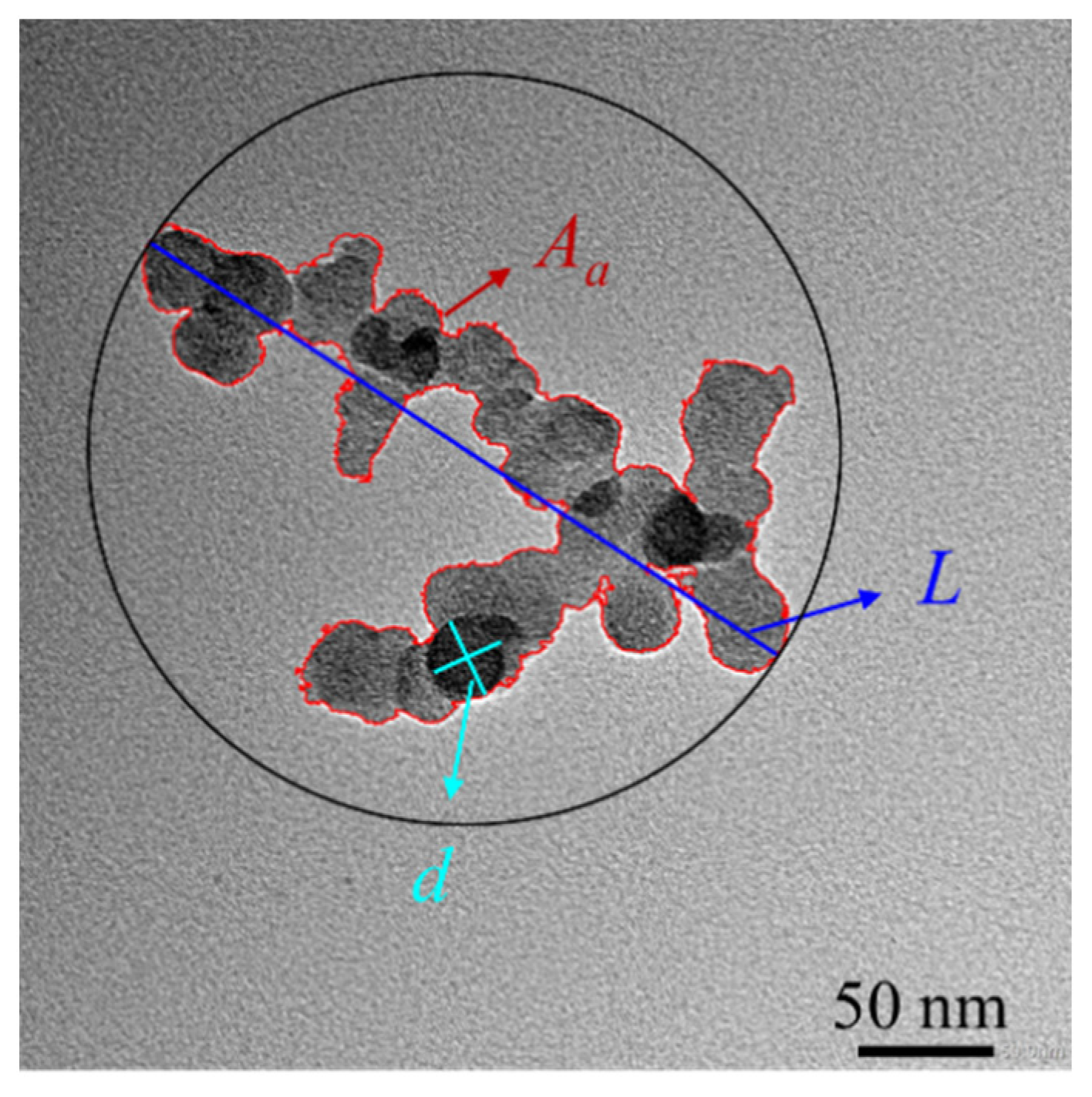
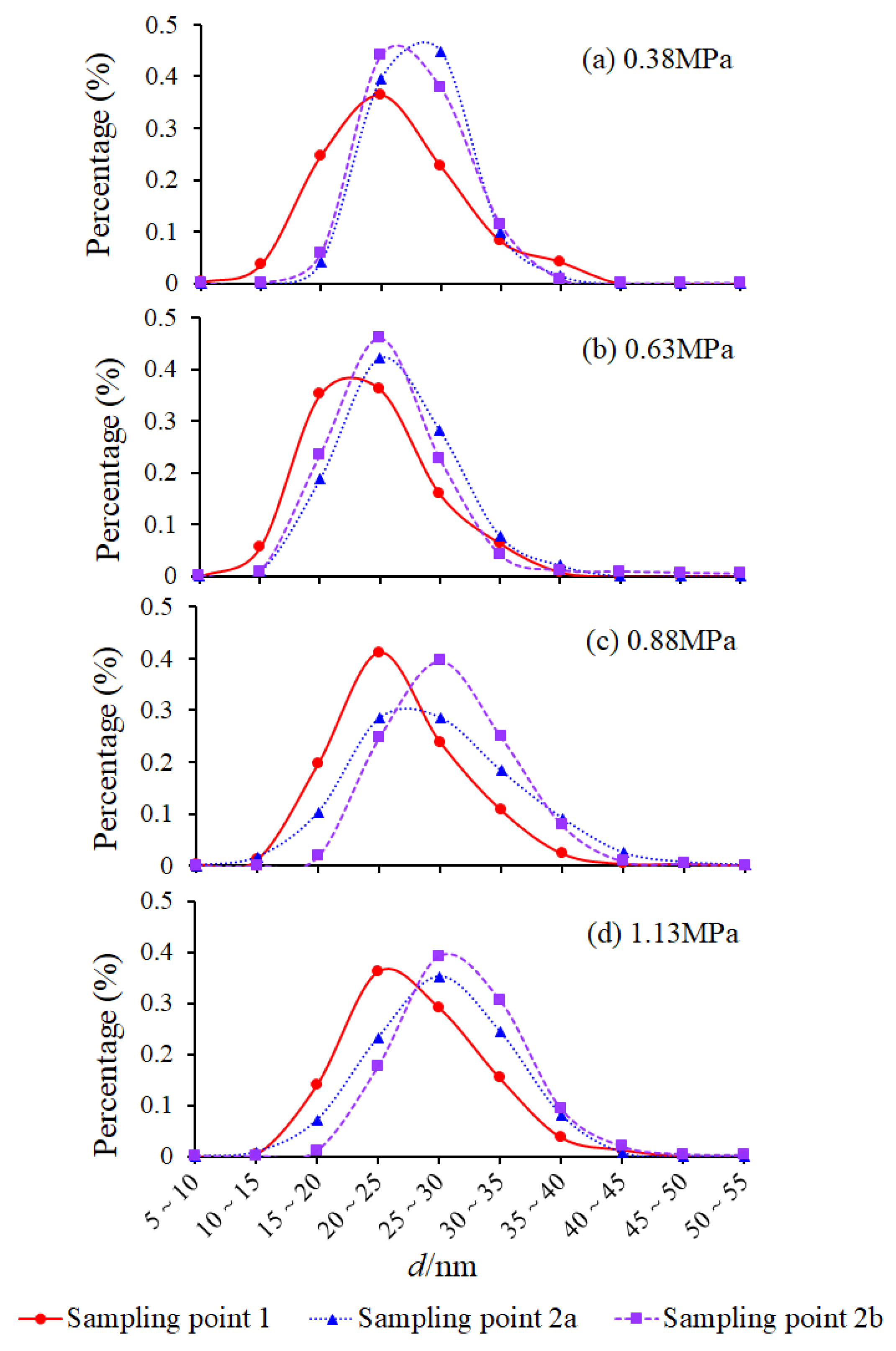
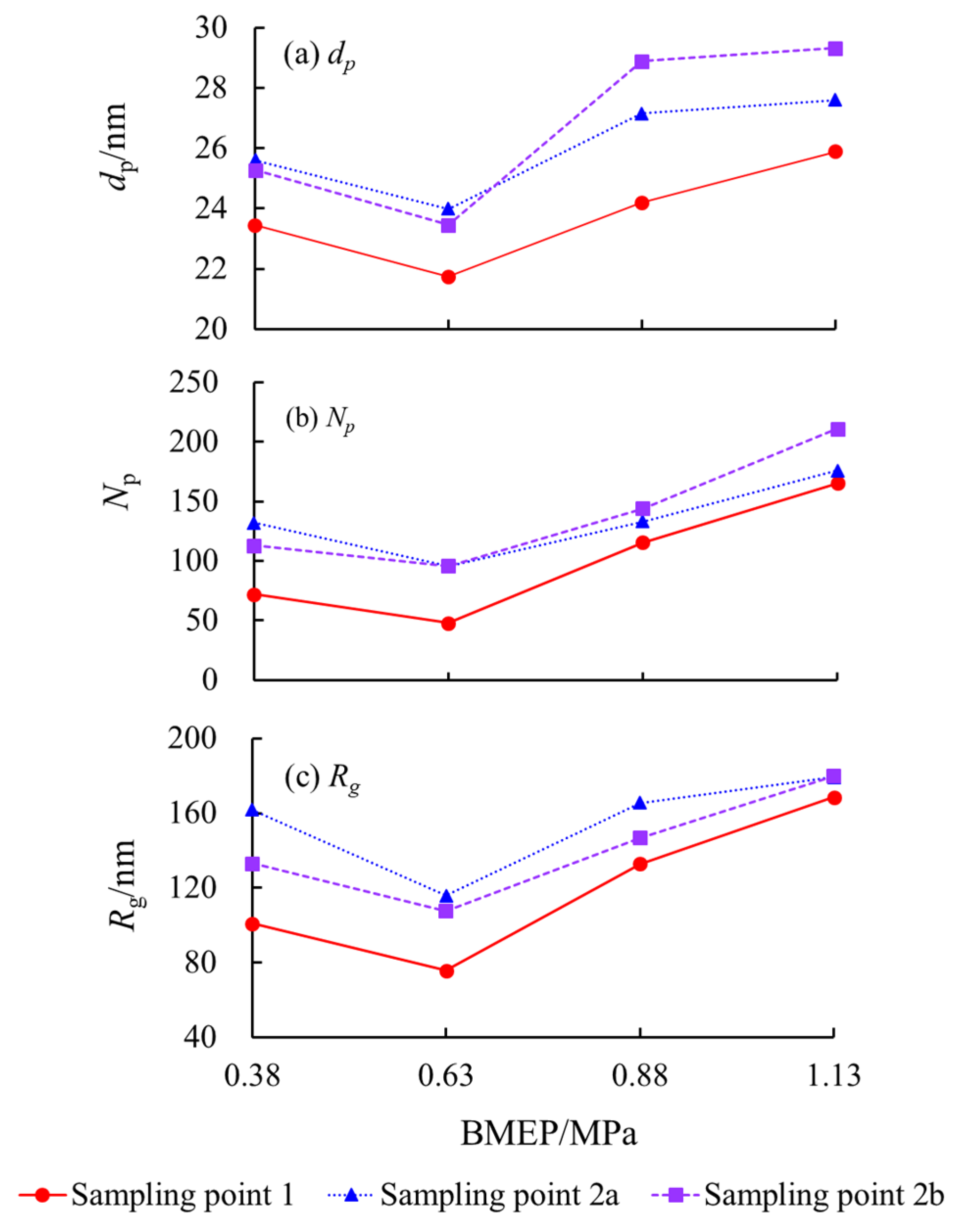
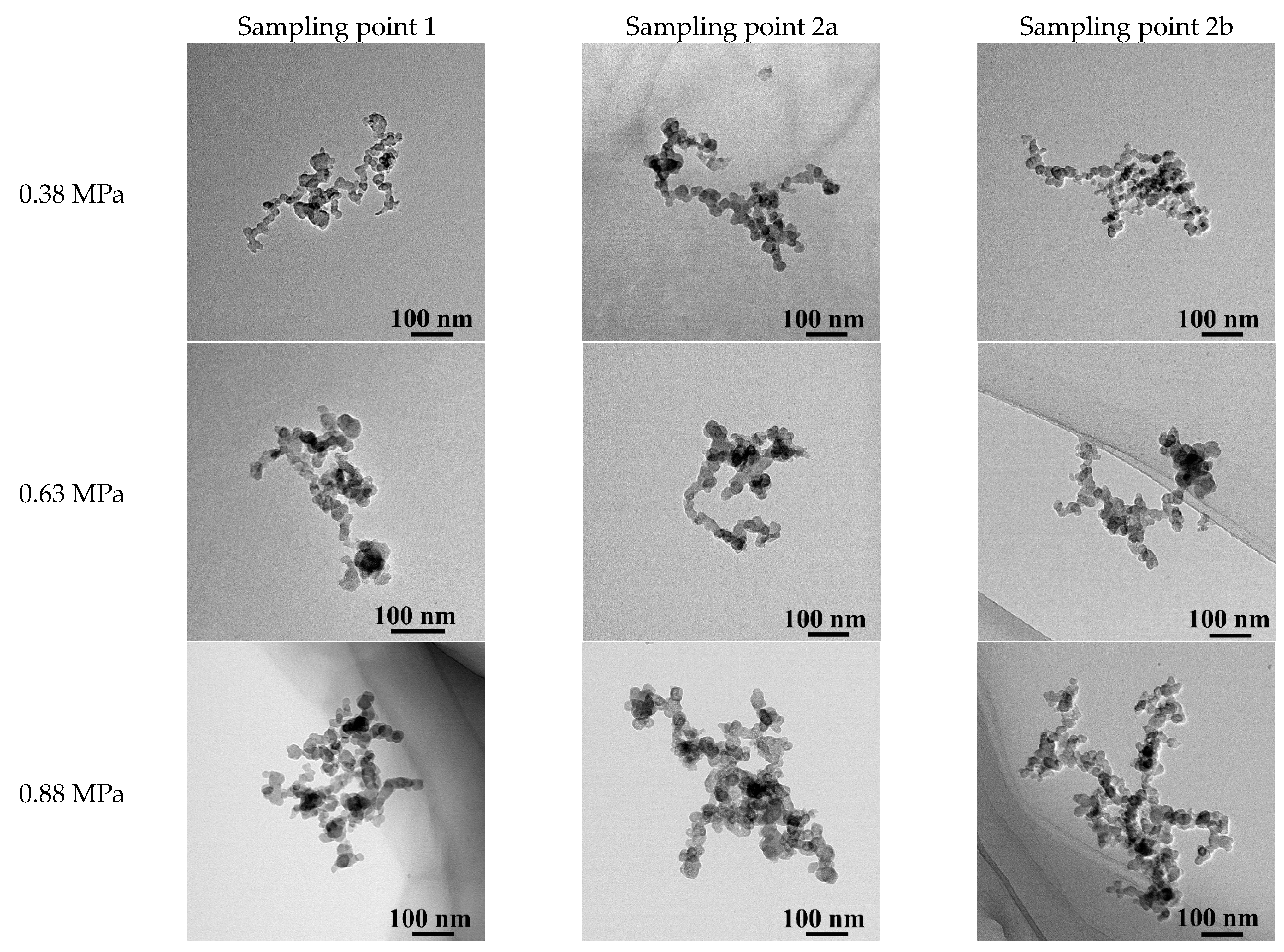

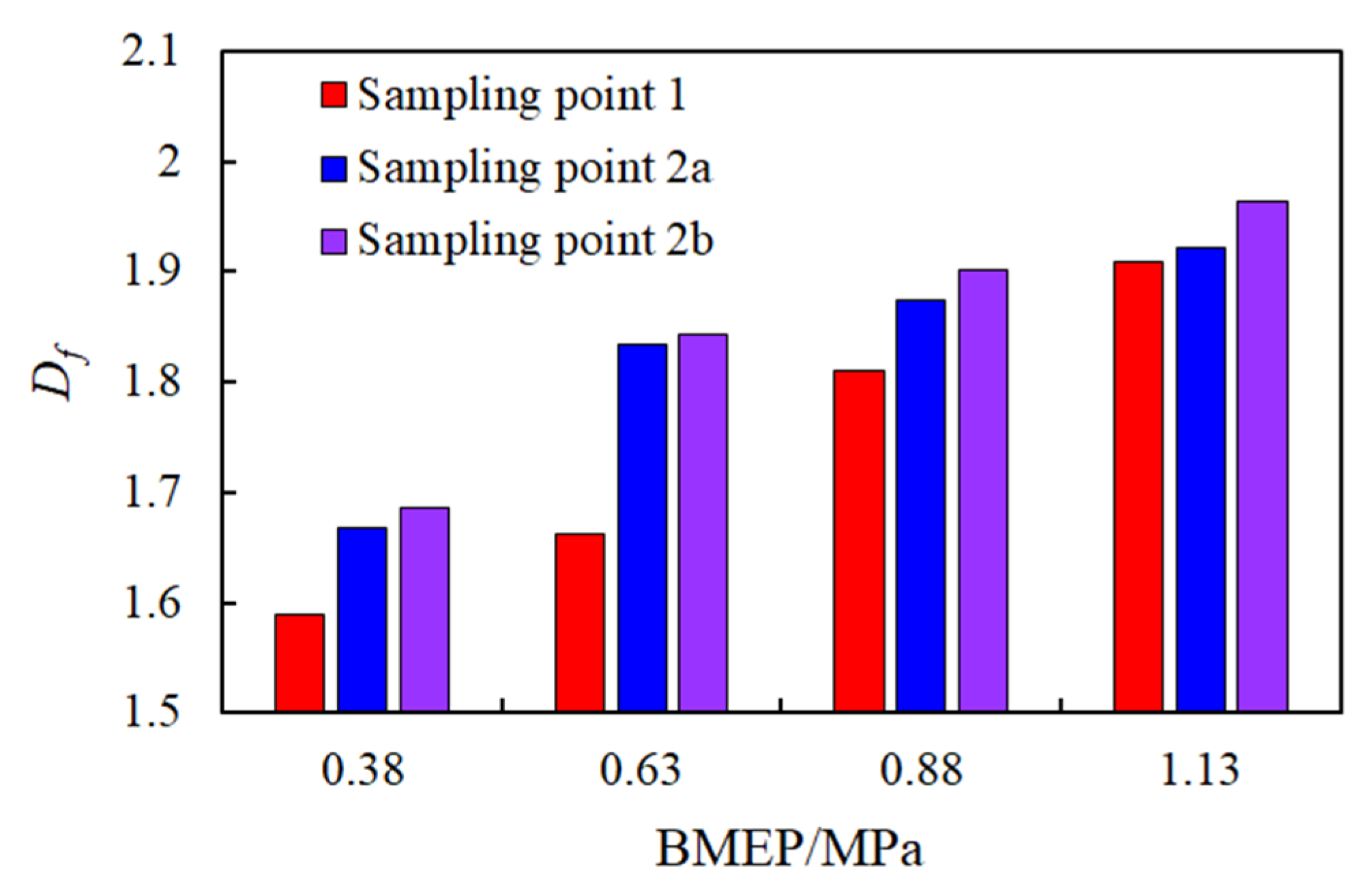


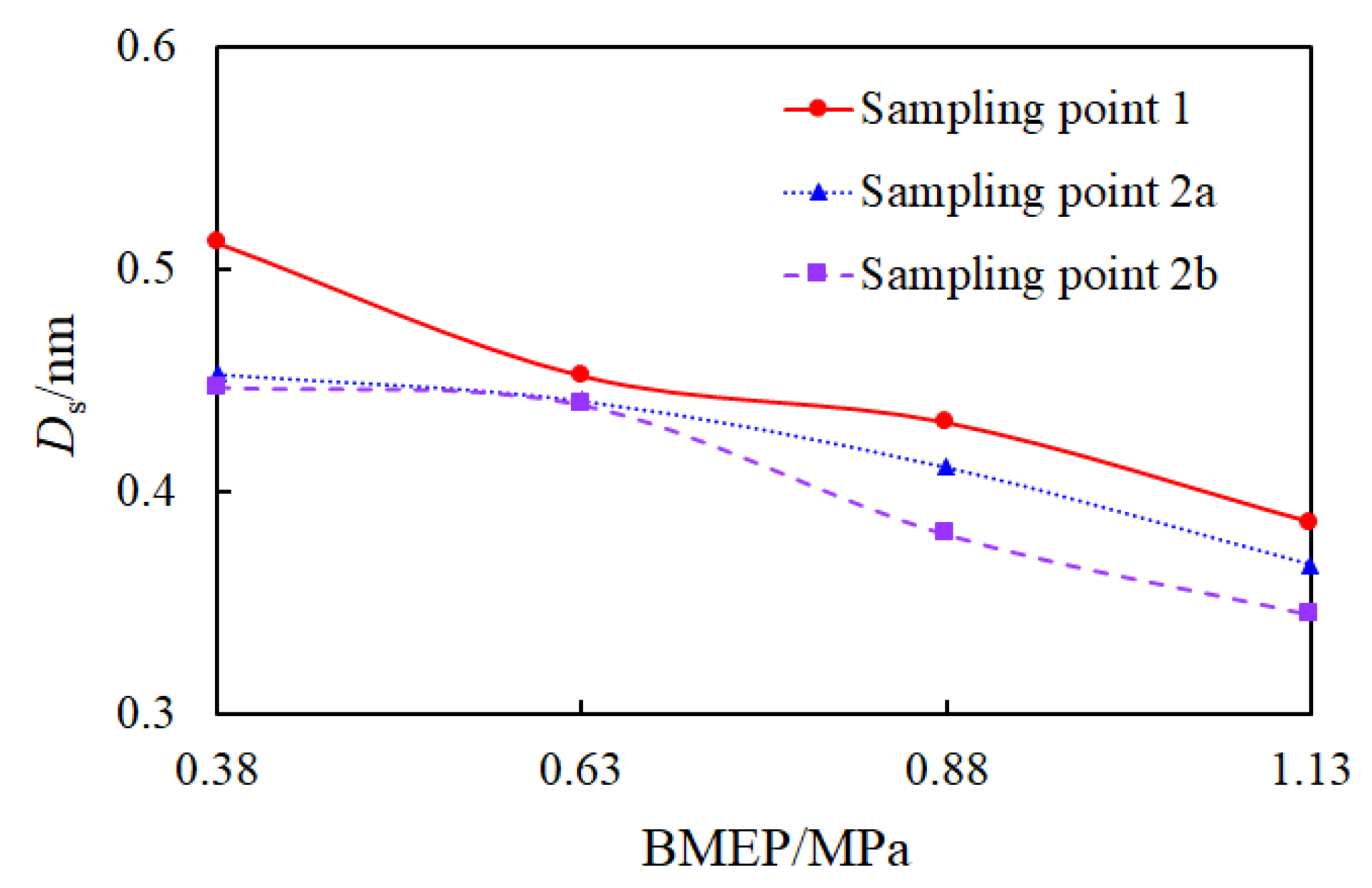
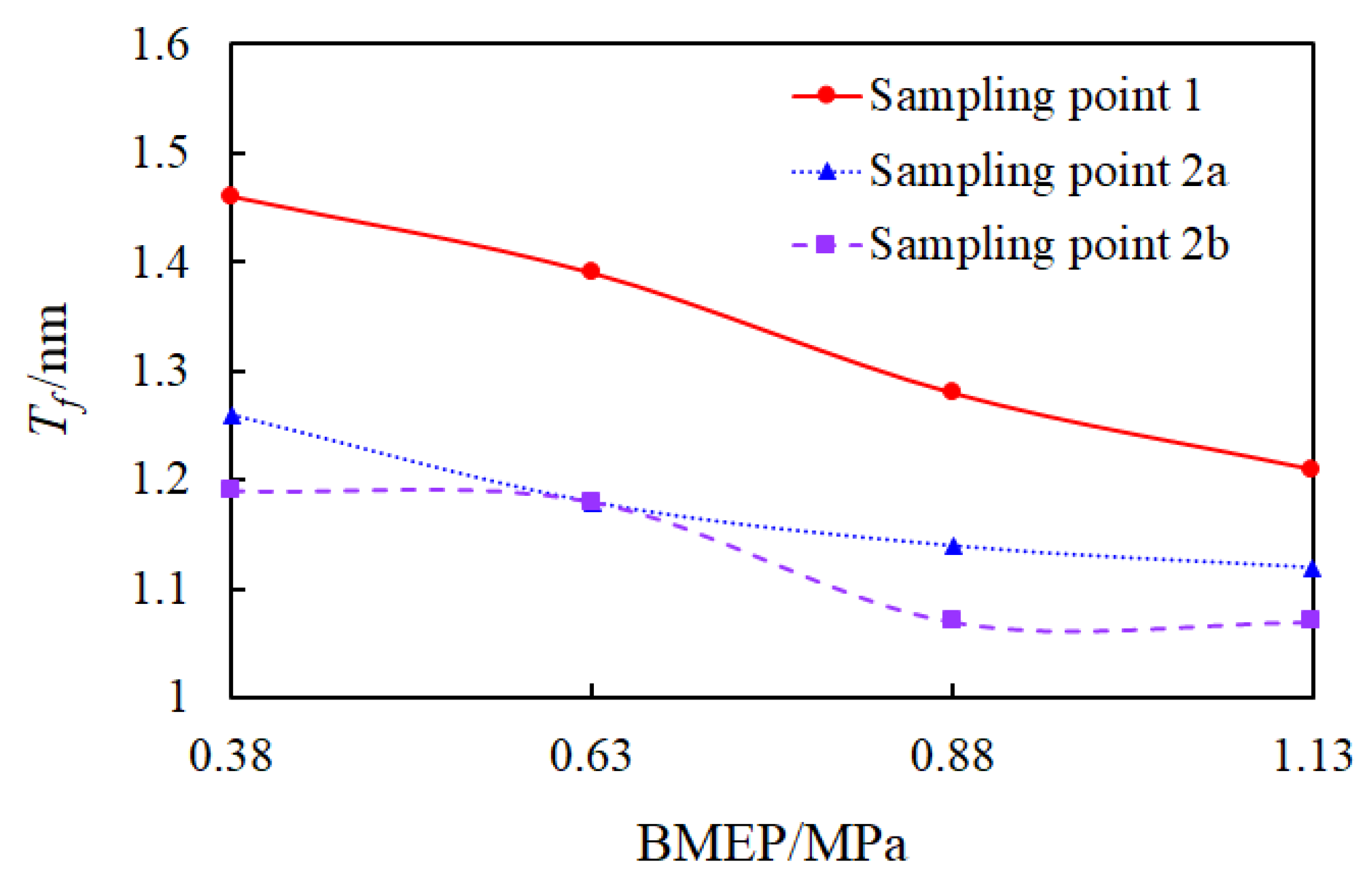
| Characteristics | Value | Characteristics | Value |
|---|---|---|---|
| Type of engine | Four-cylinder, four-stroke | Displacement/L | 2.982 |
| Type of ignition | Compression ignition | Compression ratio | 17.5 |
| Initial injection | 7.5° CA BTDC | Rated power/kW | 85 |
| Bore/mm | 96 | Rated speed/rpm | 3200 |
| Stroke/mm | 103 | - | - |
| BMEPs /MPa | Temperature/°C | Temperature Rise Ratio (T2b − T2a)/T2a | Exhaust Gas Velocity /m·s−1 | ||
|---|---|---|---|---|---|
| Sampling Point 1 (T1) | Sampling Point 2a (T2a) | Sampling Point 2b (T2b) | |||
| 0.38 | 146.8 | 89.6 | 119.7 | 20.5% | 2.8 |
| 0.63 | 197.3 | 125.4 | 158.8 | 22.0% | 3.28 |
| 0.88 | 259.7 | 159.6 | 217.9 | 22.4% | 3.83 |
| 1.13 | 354.9 | 249.6 | 332.4 | 20.1% | 4.71 |
Disclaimer/Publisher’s Note: The statements, opinions and data contained in all publications are solely those of the individual author(s) and contributor(s) and not of MDPI and/or the editor(s). MDPI and/or the editor(s) disclaim responsibility for any injury to people or property resulting from any ideas, methods, instructions or products referred to in the content. |
© 2023 by the authors. Licensee MDPI, Basel, Switzerland. This article is an open access article distributed under the terms and conditions of the Creative Commons Attribution (CC BY) license (https://creativecommons.org/licenses/by/4.0/).
Share and Cite
Ju, H.; Bian, F.; Wei, M.; Zhang, Y. Effect of Temperature on Morphologies and Microstructures of Soot Particles in the Diesel Exhaust Pipe. Energies 2023, 16, 5488. https://doi.org/10.3390/en16145488
Ju H, Bian F, Wei M, Zhang Y. Effect of Temperature on Morphologies and Microstructures of Soot Particles in the Diesel Exhaust Pipe. Energies. 2023; 16(14):5488. https://doi.org/10.3390/en16145488
Chicago/Turabian StyleJu, Hongling, Fanquan Bian, Mingrui Wei, and Yi Zhang. 2023. "Effect of Temperature on Morphologies and Microstructures of Soot Particles in the Diesel Exhaust Pipe" Energies 16, no. 14: 5488. https://doi.org/10.3390/en16145488






